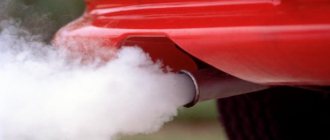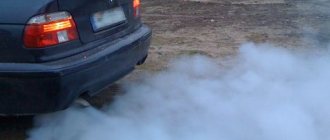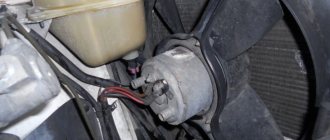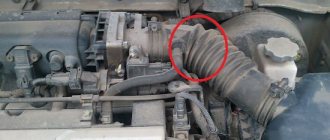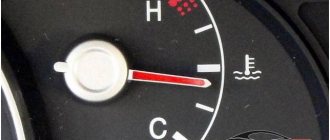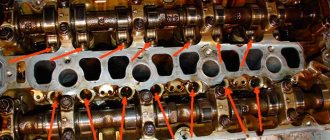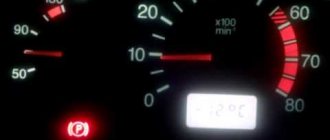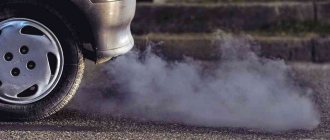White smoke from the exhaust pipe is a common occurrence in winter, so, as a rule, few people pay attention to it, but in the summer, when it is warm, thick white exhaust is alarming, both for owners of diesel cars and cars with a gasoline engine. Let's figure out why white smoke appears from the exhaust, whether the reasons are dangerous , and how to find out its origin .
Harmless smoke, or rather white steam, should not have a special odor, since it is formed due to the evaporation of accumulated condensate in the exhaust system pipes and in the engine itself at an air temperature below +10°C. Therefore, it should not be confused with smoke, which will indicate problems in the cooling system or the engine itself.
White smoke is a sign of increased humidity in the exhaust system
. After the engine warms up, the steam and condensate disappear, but if smoke still comes out of the exhaust, then this is a sign of engine malfunction.
The smoke coming from the muffler should be colorless
.
White smoke from exhaust cause
Most problems that cause white smoke from the exhaust pipe are caused by engine overheating or poor fuel supply. By paying attention to the shade of smog, its smell and the general behavior of the car, you can accurately determine the cause of the smoke. The most common are:
- Presence of moisture.
- Presence of water in fuel.
- Incorrect operation of the injection system.
- Incomplete combustion of fuel.
- Coolant entering the cylinders.
It is worth noting that some of the reasons why dangerous white smoke appears from the exhaust pipe of a diesel engine and the exhaust pipe of a gasoline engine may have different origins, so let’s deal with everything in order, and separately.
What is exhaust
It is not entirely correct to compare exhaust gases with the air exhaled by a person, but there is an analogy here. In both cases, atmospheric air is supplied to the input, and at the output we get a certain mixture of gases with a low oxygen content, and most of this mixture is water and carbon dioxide. But since the air contains a lot of nitrogen, when it burns in car cylinders, nitrogen oxides (NO) are also formed, which are considered air pollutants, and they are considered the culprits of “acid” rain. But not only air, but also fuel does not burn completely, resulting in the formation of carbon compounds (CH and CO). And if we take into account that lubricating fluid and other substances somehow get into the fuel assembly, then when they burn, the exhaust is replenished with other harmful gases. They are partially neutralized by filters and a catalyst, but in most cases this is not enough. In addition, filtration systems become less efficient over time, so the composition of the exhaust gases changes, and with it the color and smoke from the muffler changes.
However, the appearance of thick smoke does not always indicate that the catalytic converter needs to be changed. Moreover, such symptoms do not indicate problems with the self-regulation mechanism, but rather more serious malfunctions of other components of the car, and above all, the power unit.
Therefore, it is worth knowing what kind of smoke should normally come from the exhaust pipe, and what it means if it changes color and intensity.
White smoke from the exhaust pipe of a diesel engine
White exhaust during the warm-up mode of a working diesel engine is quite normal. But after the engine has reached operating temperature, such smoking may indicate:
- Condensation in solarium.
- Incomplete combustion of diesel fuel.
- Fuel overflow due to malfunction of injectors.
- Coolant leaking into the manifold.
- Low compression.
It is also worth noting that in vehicles with a FAP/DPF particulate filter, white smoke may appear from the muffler when soot particles are burned.
To diagnose a specific cause, you need to follow a few simple steps:
- First, check the color of the smoke , is it pure white or has some tint (bluish smoke will indicate burnt oil).
- Secondly, check the coolant level for the presence of exhaust gases and the presence of oil in the cooling system.
A whitish-gray exhaust when warming up may indicate untimely ignition of the mixture . This color of smoke indicates that the gases that were supposed to push the piston in the cylinder ended up in the exhaust pipe. Such smoke, as well as with the evaporation of moisture, disappears after warming up, if everything is in order with the ignition of the car.
Symptoms of a burnt cylinder head gasket
The presence of thick white smoke even after warming up indicates that coolant has entered the engine cylinder . The place where liquid penetrates can be either a burnt gasket or a crack . You can check the theory of coolant entering from the cooling system in this way:
- opening the cap of the expansion tank or radiator, you will see an oil film;
- you may smell exhaust gases from the tank;
- bubbles in the expansion tank;
- the fluid level will increase after starting the engine and decrease after stopping it;
- Pressure increases in the cooling system (can be checked by trying to compress the upper radiator hose when starting the engine).
If you notice signs of coolant getting into the cylinders, then further operation of the faulty engine is not recommended , since the situation can quickly worsen due to a decrease in the lubricating properties of the oil, which gradually mixes with the coolant.
Antifreeze in engine cylinders
Blue smoke
Typically, blue exhaust is the result of engine oil getting into the fuel assembly. It’s not for nothing that blue smoke coming from the muffler is referred to as “oil smoke.” It is easy to assume that such a phenomenon is accompanied by increased consumption of lubricating fluid. In normal operating mode of the power unit at a consumption of MM 10 g/100 km. blue smoke from the muffler will be observed exclusively in transient conditions. If there are oil leaks, then this result will be typical for all modes of operation of the power unit.
For experienced motorists, it will not be difficult, focusing on certain signs, to clarify the reason for the appearance of colored exhaust, which helps to quickly solve the problem.
It is enough for novice owners to know that all such cases are divided into two large categories:
- when the blue-white color of the exhaust is present only when the car is warming up, and subsequently disappears, this is a normal phenomenon caused by natural thermal processes: when heated, metal parts expand, reducing the gaps, and oil leaks stop, and the exhaust returns to normal;
- if blue smoke coming from the exhaust pipe is observed even on a warm engine, we can talk about significant wear of the power unit components, that is, thermal expansion is no longer enough to reliably seal the gaps, which leads to the penetration of engine oil into the CPG.
In both the first and second cases, losses of lubricating fluid are inevitable, however, if in the absence of wear the consumption rates are minimal (we have already given them - a maximum of 10 grams of oil per hundred kilometers), then for the second category they can be significant.
This is why the recommendation to check the MM level using a dipstick every day is so obsessively suggested in most materials devoted to the proper operation of the car. Of course, it is impossible to detect such microscopic doses as 10-100 g on the dipstick, but the loss of 0.5-1 liters of lubricating fluid will noticeably shift the readings towards the MIN risk. In this case, the vehicle owner should immediately begin to look for the cause of the drop in oil level - this will help prevent engine damage and, accordingly, considerable expenditure of money on its repair.
Note that on vehicles equipped with a catalytic converter (which is most modern makes and models), a drop in oil level may not be accompanied by a change in the color of the exhaust, since this device is able to clean most of the harmful components of the exhaust gas.
Many drivers determine the degree of CPG wear by the compression level, which is not entirely correct. The fact is that oil leaks while the engine is running is a positive phenomenon in a certain sense: it seals the gaps, and if they do not exceed the norm too much, the crankcase gas pressure and compression will be normal. This means that when using a compression meter, you cannot get distorted results. That is why it is advisable to combine this procedure with checking the engine oil level.
Now let’s look at what kind of gaps we are talking about, that is, in what ways the lubricant penetrates into the cylinders. Most often, oil enters the combustion chamber through the piston rings, but there is another way - increased clearance between the valve stems and guide bushings.
White smoke from the exhaust pipe of a gasoline engine
As stated earlier, the release of white steam from the exhaust in cold and humid weather is a completely natural phenomenon; before warming up, you can even see it dripping from the muffler, but if the engine is at an optimal temperature, and steam continues to escape, then you can be sure that the engine there are problems.
The main reasons why white smoke comes out of the exhaust pipe of a gasoline engine are:
- Leaking coolant into the cylinder.
- Injector malfunction.
- Low-quality gasoline with foreign impurities.
- Burnout of oil due to the presence of rings (smoke with a tint).
The reasons why white smoke may appear from the exhaust of a gasoline car may only partially differ from those affecting a diesel engine, so we will pay more attention to how to check exactly why the smoke began to pour out.
Black smoke
The appearance of black smoke from the exhaust pipe does not indicate a major breakdown of the engine or other systems. But if the cause of this phenomenon is not eliminated in a timely manner, then this can really lead to serious problems with the engine, ignition system and supply system.
The formation of black smoke indicates an oversaturated fuel-air mixture. Such a large amount of fuel enters the cylinders that it does not have time to burn effectively, which is why the exhaust becomes dark in color. Such exhaust is much more toxic than the ordinary exhaust of a properly running car.
The main cause of black smoke is a malfunctioning fuel supply system. The reason may also be a malfunction of the ignition system, as a result of which the fuel does not ignite inside the chamber, which is why the mixture comes out in a raw state through the muffler. Another characteristic of such a case is that the engine will “trouble” a lot.
If the exhaust is gray-black, this may indicate that the carburetor is not working properly. Often the reason lies in the overflow of the float chamber.
- This may occur due to a faulty needle valve, which may allow excess fuel to pass through or, on the contrary, stick.
- The jets may be clogged.
To fix such problems, you need to disassemble the carburetor and clean it thoroughly. If this does not help, then you should buy a repair kit, replace the jets and needle valve and correctly set the gasoline level inside the chamber.
In the case of an injection engine, the problem can be solved by cleaning the injector itself. It may also be necessary to replace the fuel pump or one of the sensors that monitor various cycles. In the second case, it is unlikely that you will be able to solve the problem on your own; you will have to go to a workshop, where, using special equipment, they will be able to correctly diagnose the faulty element and replace it.
From novice drivers you can often hear questions related to exhaust, and specifically about why the car produces so much smoke. This mainly concerns the formation of thick white smoke, which can appear in the morning when the driver starts a cooled engine, but white smoke can also appear while the car is moving.
Why does diesel smoke when cold?
The exhaust of a working engine is transparent. If it is thick and tinged, then this is a sign of trouble:
- The injectors are clogged with low-quality fuel resins.
- The air filter is clogged.
- Turbocharger malfunction due to manifold leakage or air duct failure.
- Incorrect injection angle of the injection pump.
- Problem with glow plugs.
In most of these cases, diesel fuel is difficult to ignite and burns partially. In addition, these defects lead to a drop in engine power.
Why this problem cannot be ignored
If white smoke comes from the exhaust pipe, which is a consequence of a malfunction of some vehicle elements in the internal combustion engine, you must act quickly. Mixing antifreeze and oil is a useless emulsion that has low lubricating properties. A protective film still forms on the cylinder walls, however, it is not of the required quality. All this leads to the formation of carbon deposits, burnout of cooling and lubricants and rapid wear of various structural elements. If no action is taken, the engine will run almost dry, which will sooner or later lead to a wedge.
